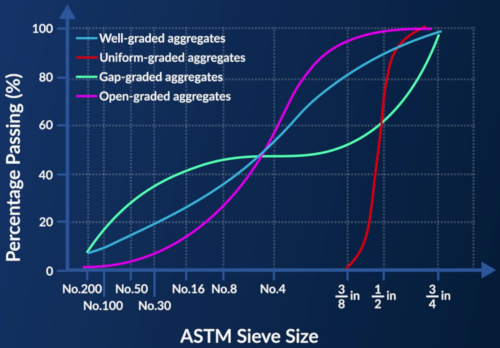5.5 : Tipi di classificazione degli aggregati
La classificazione degli aggregati è fondamentale per ottenere economicamente una miscela di calcestruzzo con resistenza adeguata, ragionevole lavorabilità e minima segregazione. Esistono quattro tipi di classificazione degli aggregati: ben graduati, uniformemente graduati (o a singola dimensione), discontinui e a gradazione aperta.
Gli aggregati ben graduati includono una gamma completa di frazioni dimensionali necessarie che si adattano insieme per creare una matrice densa con vuoti minimi, rappresentata da una curva di gradazione continua e regolare. Questo tipo di classificazione garantisce una buona lavorabilità e stabilità per il calcestruzzo.
Al contrario, gli aggregati uniformemente graduati o a singola dimensione sono costituiti prevalentemente da particelle della stessa dimensione, il che è evidente da una curva di gradazione quasi verticale. Sebbene questi aggregati offrano una buona permeabilità, mancano di stabilità e sono generalmente utilizzati in applicazioni specifiche, come i trattamenti superficiali nelle pavimentazioni stradali.
Gli aggregati classificati come discontinui sono caratterizzati dall'assenza di determinate frazioni dimensionali, causando il passaggio di una porzione significativa di particelle attraverso due setacci molto diversi. Ciò determina una curva di gradazione con una sezione quasi orizzontale, indicativa di dimensioni intermedie mancanti. A causa delle dimensioni mancanti del materiale, questi aggregati possono causare problemi di stabilità del calcestruzzo.
Gli aggregati a gradazione aperta, a cui mancano dimensioni più piccole che riempiono i vuoti tra aggregati più grandi, presentano una curva di gradazione piatta con valori minimi nell'intervallo di dimensioni più piccole. Questi aggregati sono altamente permeabili ma hanno una stabilità ridotta.

Dal capitolo 5:

Now Playing
5.5 : Tipi di classificazione degli aggregati
Aggregates and Water
426 Visualizzazioni

5.1 : Inadeguatezza dell'aggregato a causa della variazione di volume
Aggregates and Water
98 Visualizzazioni

5.2 : Sostanze nocive in aggregato
Aggregates and Water
153 Visualizzazioni

5.3 : Analisi del setaccio e curve di classificazione
Aggregates and Water
313 Visualizzazioni

5.4 : Modulo di Finezza
Aggregates and Water
284 Visualizzazioni

5.6 : Dimensione massima dell'aggregato
Aggregates and Water
86 Visualizzazioni

5.7 : Qualità dell'acqua
Aggregates and Water
87 Visualizzazioni

5.8 : Test della qualità dell'acqua
Aggregates and Water
103 Visualizzazioni

5.9 : Classificazione degli aggregati
Aggregates and Water
305 Visualizzazioni

5.10 : Forma e consistenza degli aggregati grossolani
Aggregates and Water
197 Visualizzazioni

5.11 : Legame e resistenza dell'aggregato
Aggregates and Water
140 Visualizzazioni

5.12 : Tenacità e durezza dell'aggregato
Aggregates and Water
248 Visualizzazioni

5.13 : Peso specifico degli aggregati
Aggregates and Water
223 Visualizzazioni

5.14 : Densità apparente dell'aggregato
Aggregates and Water
417 Visualizzazioni

5.15 : Porosità e assorbimento degli aggregati
Aggregates and Water
264 Visualizzazioni
See More